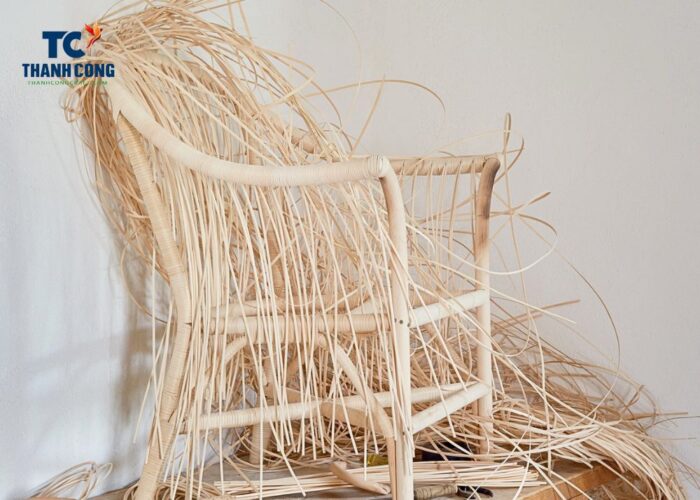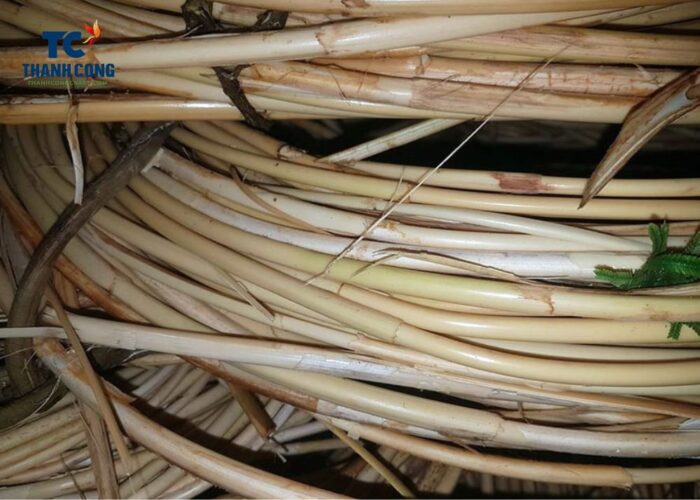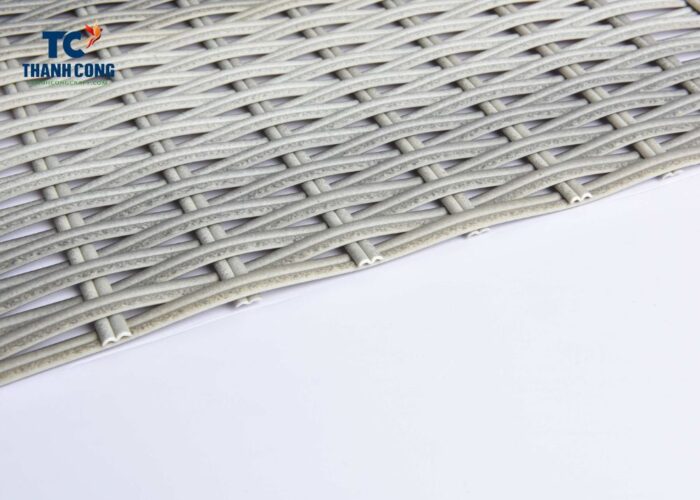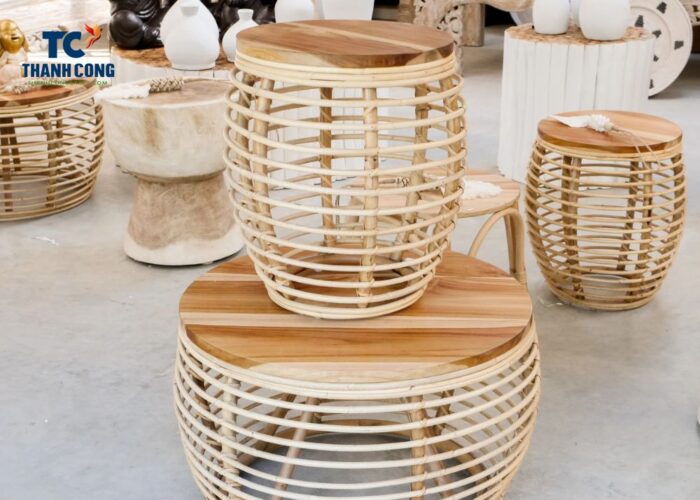With the trend transitioning from tradition to modernity, the rattan plant is becoming increasingly recognized and utilized. It plays a significant role in preserving the cultural identity of ethnic groups, especially contributing to greener living spaces and ensuring human health safety. Yet, have you ever wondered about what is rattan made of? Let’s find out in the article below.
Contents
1. What is rattan?
The scientific name of the rattan plant is Calamus tetradactylus Hance. There are around 600 natural species of rattan distributed in tropical regions across Asia, Australia, and Africa. In Vietnam, the Forestry Department recognizes rattan as a non-timber forest product used as a raw material for creating artistic and interior pieces, including items like tables, chairs, and room dividers.

2. What is rattan made of?
Rattan is made from the stems of climbing palms belonging to the genus Calamus. Let’s delve into the most detailed understanding of the components of the rattan plant!
- Stem rattan: The stem of the bamboo plant is not only visually appealing but also remarkably flexible, making it easy to bend and work with. The underground stem, often dark in color, lies close to the ground. The above-ground stem segments develop into clusters, each with multiple stems emerging from the underground stem. The vital stem can have a diameter ranging from 0.8cm to 1.2cm, varying with soil conditions and climate. It can reach lengths of up to 30 meters or even more. Encased in layers of green leaf sheaths, it also boasts sharp thorns, making it a preferred choice for constructing protective fences. The stem is divided into numerous segments, each around 15 to 40cm long.
- Roots:The roots of the bamboo plant are robust and capable of firmly anchoring into the soil. With rapid growth, bamboo roots readily adapt to various living conditions. The root’s outer layer is tough, while the inner core is sturdy. The roots tend to form surface protrusions as they develop. For mature or large underground-stemmed bamboo plants, the root system can be substantial.

- Leaves: Bamboo leaves are single and resemble bird feathers. Fully grown leaves can extend up to a meter, organized into clusters of 2 to 4 leaves each. On average, leaf blades are about 30cm long and 2 to 3 cm wide.
- Flowers: Bamboo plants produce flowers in clusters, usually in May and June each year. Unique to bamboo, the flower spikes prominently develop at the tip. Each flower cluster contains multiple smaller flower clusters, bearing fragrant, distinctively scented yellow flowers.
- Fruits: Bamboo fruits typically appear around 4 to 5 years after planting and care. The fruit is small in comparison to the stem, with a diameter of approximately 0.6cm and a spherical shape. The fruit’s surface features layered, large scales. A mature bamboo plant can bear around 5000 fruits, each containing a single seed.
3. What is PE rattan made of?
What is pe rattan made of? Plastic rattan fibers are made from premium synthetic materials, often referred to as PE plastic, although in reality, it is PPE, an acronym for Polyphenylene Ether (ppe). This falls under the category of amorphous materials and has the capacity to withstand temperatures ranging from -40º to 90º C. It can endure high impacts and is water-resistant, making it an ideal choice for both household and interior-exterior design.
When used for interior and exterior products, the plastic rattan fibers are additionally coated with a UV-resistant layer, enhancing their ability to withstand harsh weather conditions like rain, wind, and sun. Furthermore, they are resistant to moisture and mold, a feature that traditional woven rattan cannot achieve, making them particularly useful in humid and warm climates.
Plastic rattan comes in a wide array of colors, contributing to a significant architectural breakthrough when integrated into interior and exterior designs. This is especially noteworthy in spaces such as cafes, hotels, and resorts, where plastic rattan has introduced a substantial transformation in the architectural landscape.
4. Comparison: PE rattan with rattan
Material Composition:
- PE Rattan: Crafted from high-density polyethylene (HDPE) resin, a synthetic material engineered to replicate the appearance and texture of natural rattan.
- Natural Rattan: Derived from the stems of climbing palms belonging to the Calamus genus.
Durability:
- PE Rattan: Highly durable and resistant to weather conditions, UV rays, and moisture.
- Natural Rattan: Durable but more susceptible to weathering and UV damage over time.
Appearance:
- PE Rattan: Offers a wide range of color and pattern options due to its synthetic nature.
- Natural Rattan: Displays a natural, earthy aesthetic with its own variations in color and texture.

Maintenance:
- PE Rattan: Requires minimal maintenance, easy to clean with water and mild soap.
- Natural Rattan: Needs periodic cleaning and protection from extreme weather conditions.
Eco-Friendliness:
- PE Rattan: Not biodegradable, contributes to plastic waste.
- Natural Rattan: Natural rattan brings an authentic, eco-friendly, and timeless aesthetic, but requires more care and may be relatively pricier.Biodegradable and environmentally friendly. As a result, rattan is employed in crafting a multitude of items, including rattan plants, rattan baskets, and rattan garden furniture…
Comfort:
- PE Rattan: Less breathable in extreme temperatures, can get uncomfortably hot.
- Natural Rattan: Offers better breathability and comfort.
Longevity:
- PE Rattan: Typically has a shorter lifespan compared to natural rattan due to plastic composition.
- Natural Rattan: is rattan durable? It can endure for decades with appropriate maintenance.

Aesthetics:
- PE Rattan: Synthetic appearance, may lack the authenticity of natural rattan.
- Natural Rattan: Natural, rustic charm with unique variations.
Price:
- PE Rattan: Often more affordable due to its synthetic production.
- Natural Rattan: May be pricier due to labor-intensive harvesting and weaving processes.
Environmental Impact:
- PE Rattan: Contributes to plastic pollution and environmental concerns.
- Natural Rattan: Sustainable and eco-friendly.
The choice between PE rattan and natural rattan depends on your priorities. PE rattan offers durability, low maintenance, and versatility in appearance, but comes with environmental and comfort drawbacks. Natural rattan brings an authentic, eco-friendly, and timeless aesthetic, but rattan furniture requires more care and may be relatively pricier. Consider your preferences, lifestyle, and commitment to sustainability when making your decision.
Above is 10 Examples Of Bamboo Products, If you have any further questions, please don’t hesitate to contact Thanh Cong Craft email at info@thanhcongcraft.com or message us at WhatsApp: +84967485411. Hope to serve you soon! Best regard!












